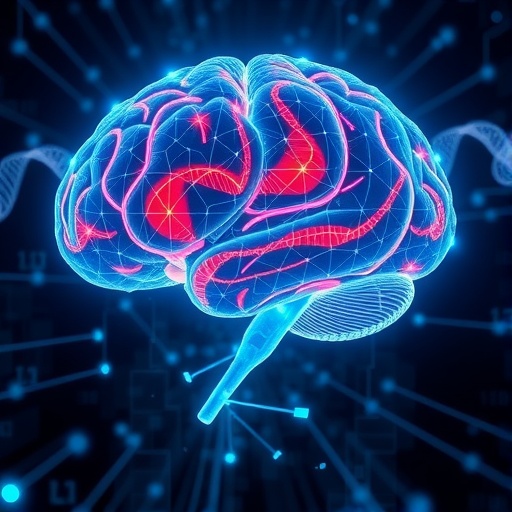In a groundbreaking study, researchers have unveiled an innovative diagnostic model for ovarian cancer that leverages the power of machine learning algorithms combined with an in-depth analysis of the essential biomarker SOX17. This research is not just a mere academic exercise; it represents a potential game-changer in how ovarian cancer may be diagnosed and treated in the coming years. The collaborative effort led by Geng, X., Yin, M., and Zhao, H., alongside their esteemed team, illustrates a significant advancement in the fight against one of the most challenging gynecological cancers.
The researchers utilized a range of machine learning techniques to process vast amounts of clinical, genomic, and biological data related to ovarian cancer. By tapping into these advanced algorithms, the team was able to identify patterns and correlations that human analysts might overlook. The application of machine learning to oncology is burgeoning, as it offers new avenues for understanding complex diseases wherein traditional methods often fall short. This study marks a critical milestone by demonstrating that such techniques can yield reliable and reproducible results in a clinical context.
At the heart of this research is SOX17, a transcription factor known to be pivotal in the regulation of genetic mechanisms associated with cell differentiation and development. Recent studies have begun to elucidate SOX17’s role in cancer biology, and its potential as a biomarker has garnered increasing attention. In ovarian cancer, where early detection often remains a significant hurdle, the presence levels of SOX17 could provide crucial insights into tumor behavior and patient prognosis. With this study, the authors aim not only to highlight SOX17’s diagnostic potential, but also to redefine the standards of ovarian cancer assessment.
The process undertaken in the study included collecting data from diverse patient cohorts, ensuring a robust and representative dataset. This approach allowed the researchers to train their machine learning models on a comprehensive array of clinical manifestations and genetic expressions linked to ovarian tumors. The ability to account for variability among patients is a hallmark of effective diagnostic models, and this research exemplifies that principle by merging ample datasets with cutting-edge technology.
Metrics of performance were rigorously assessed using various statistical approaches, showcasing the model’s high sensitivity and specificity rates when tested against existing diagnostic measures. This level of accuracy is particularly noteworthy given the historical challenges in reliably identifying ovarian cancer in its earlier stages. Ovarian cancer is often dubbed the ‘silent killer’ due to its vague symptoms; thus, the emergence of predictive models that can enhance early detection is vital for improving patient outcomes.
The implications of the research extend beyond mere diagnostics. With the insights garnered from this study, clinicians can develop personalized treatment plans tailored to the individual profiles of cancer patients. This represents a shift towards precision medicine that could redefine standard practice and enable targeted therapy approaches. By coupling the biological insights derived from SOX17 with machine learning applications, patients could receive interventions that are specifically designed based on their unique tumor characteristics.
Moreover, this diagnostic model holds profound potential for further research. The data and insights generated from the analysis of SOX17 can also pave the way for the discovery of new therapeutic targets. Understanding how SOX17 operates within the cancer signaling pathways could yield new insights into the mechanisms of tumorigenesis and metastasis, leading to novel strategies for intervention. This holistic approach, combining diagnostics and therapeutic insight, bodes well for a future replete with innovations in ovarian cancer treatment.
The study also encourages an interdisciplinary unity among researchers, oncologists, and data scientists, demonstrating the unparalleled capacity of collaborative efforts in medicine. By merging fields that are often perceived as disparate, such as bioinformatics and clinical oncology, the researchers exemplify how modern scientific inquiries are evolving. Such collaborations could be crucial to overcoming the intricacies involved in cancer pathology, bringing forth a new wave of understanding that enriches both academic and practical aspects of medical science.
The methodology adopted in this research could serve as a blueprint for future studies targeting other cancer types. As the medical community strives to enhance diagnostic protocols across various cancers, the successful application of this machine learning approach could inspire similar frameworks elsewhere, advocating for a broader implementation of technology in clinical practices.
Public health implications of such advancements in ovarian cancer diagnostics cannot be overstated. With the promise of earlier detection, there is the potential for improved survival rates and quality of life for patients. Reducing the mortality associated with ovarian cancer through innovative diagnostic techniques embodies a commitment to patient care and reflects a proactive stance in combating life-threatening illnesses.
As the findings of this study gain traction, both within the scientific community and beyond, it is imperative to translate the computational insights into actionable clinical tools. The challenge now lies in evolving this research into a tangible diagnostic solution that can be integrated into existing healthcare systems. Efforts should focus on disseminating knowledge to practitioners, validating the model in diverse clinical contexts, and navigating regulatory pathways to ensure accessibility for patients worldwide.
In conclusion, the development of this diagnostic model for ovarian cancer represents a crucial advancement at the intersection of technology and medicine. The rigorous application of machine learning algorithms combined with the functional analysis of SOX17 provides hope for a future where early diagnosis and tailored treatments become the norm. As researchers and clinicians work hand-in-hand to bring these innovations to fruition, the commitment to transforming cancer care through technology and precision will surely reshape the landscape of oncology for generations to come.
Subject of Research: Ovarian Cancer Diagnosis Through Machine Learning
Article Title: Development of a Diagnostic Model for Ovarian Cancer Based on Machine Learning Algorithms and Functional Analysis of Key Biomarker SOX17
Article References: Geng, X., Yin, M., Zhao, H. et al. Development of a diagnostic model for ovarian cancer based on machine learning algorithms and functional analysis of key biomarker SOX17. J Ovarian Res 18, 237 (2025). https://doi.org/10.1186/s13048-025-01809-w
Image Credits: AI Generated
DOI: https://doi.org/10.1186/s13048-025-01809-w
Keywords: Ovarian Cancer, Machine Learning, Diagnostic Model, SOX17, Precision Medicine, Oncology, Cancer Biomarkers, Early Detection, Bioinformatics.
Tags: advanced algorithms in healthcareadvancements in machine learning applicationsAI-driven ovarian cancer diagnosisbreakthroughs in cancer treatment methodscollaborative research in gynecological oncologygenomic data in cancer researchidentifying patterns in clinical datainnovative diagnostic models for cancermachine learning in oncologyreliable cancer diagnosticsSOX17 biomarker analysistranscription factors in cancer biology




